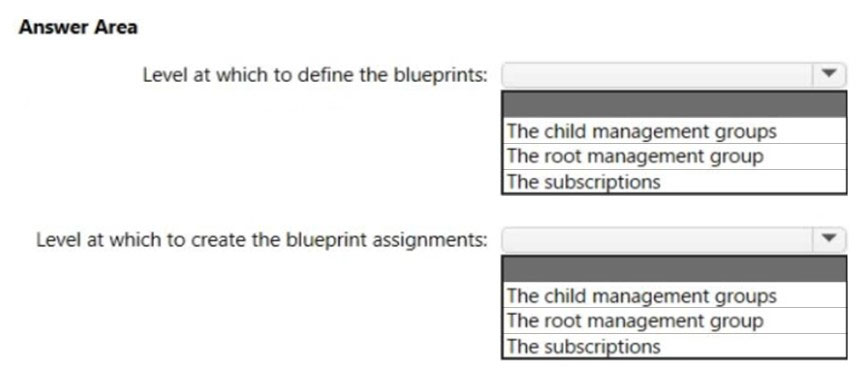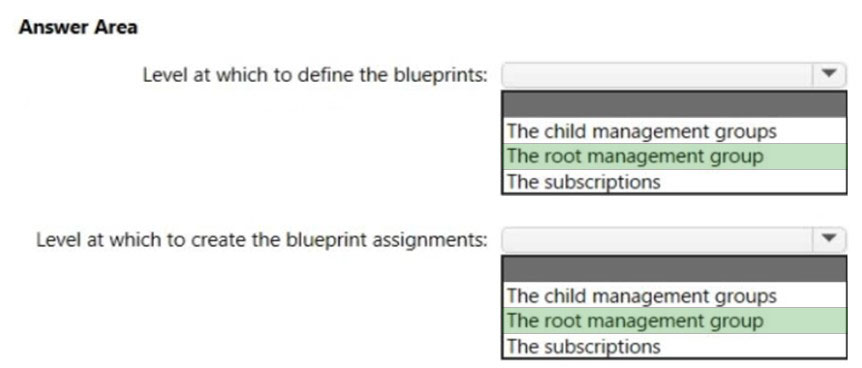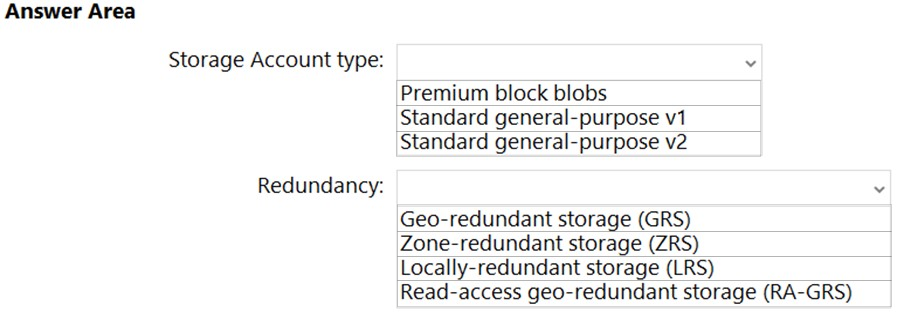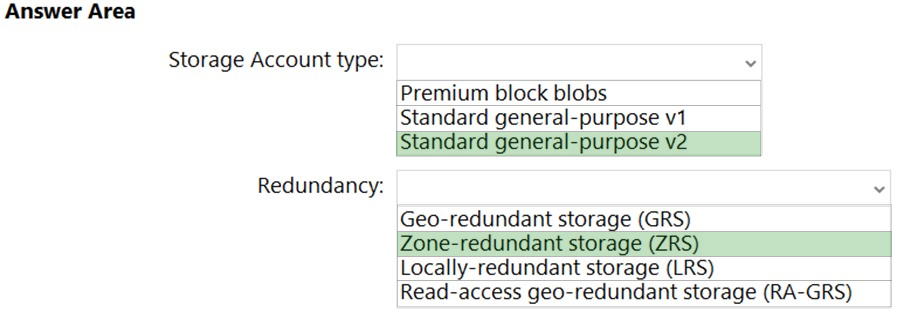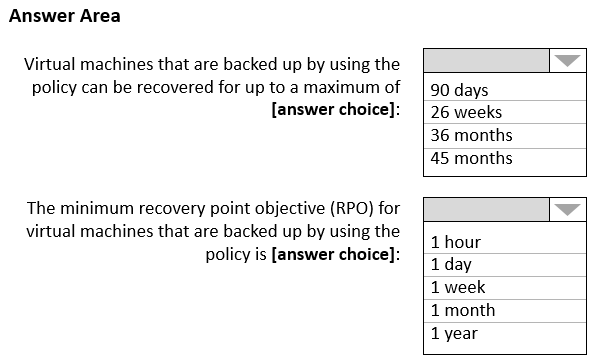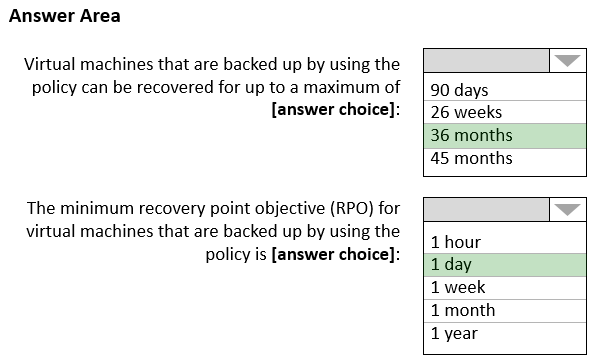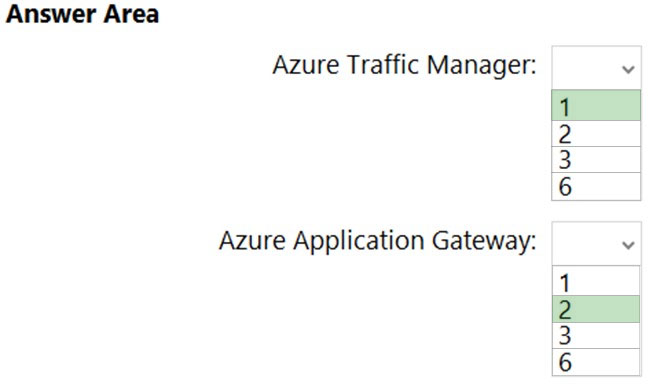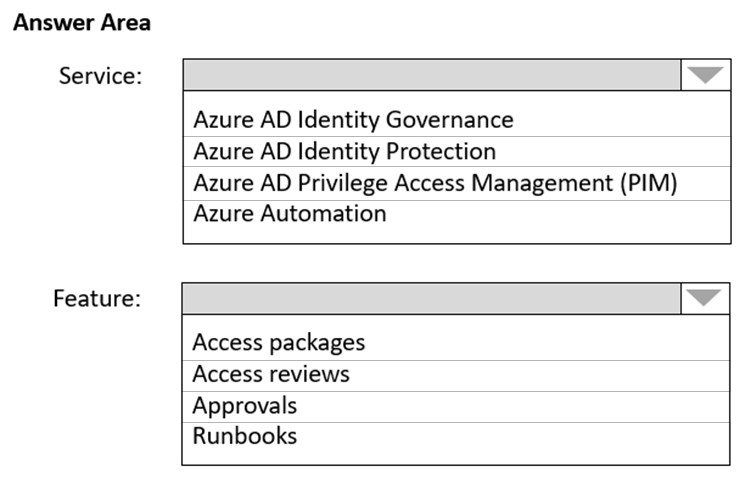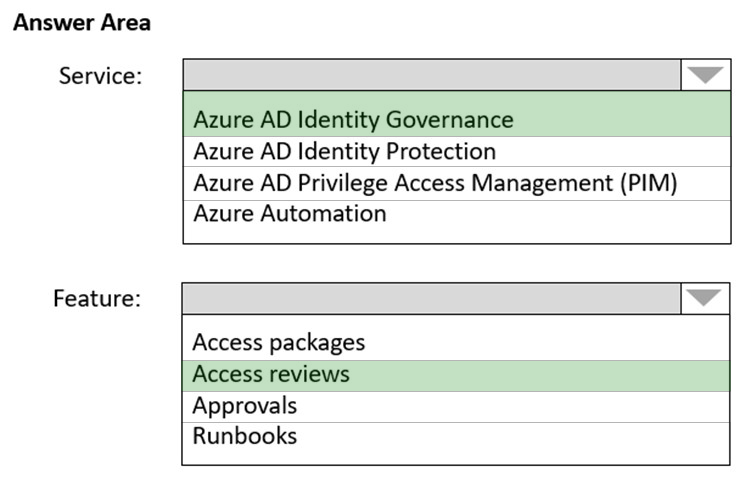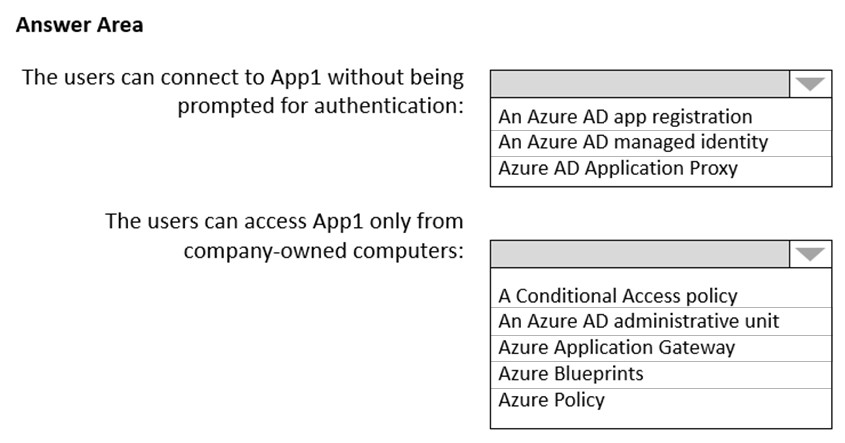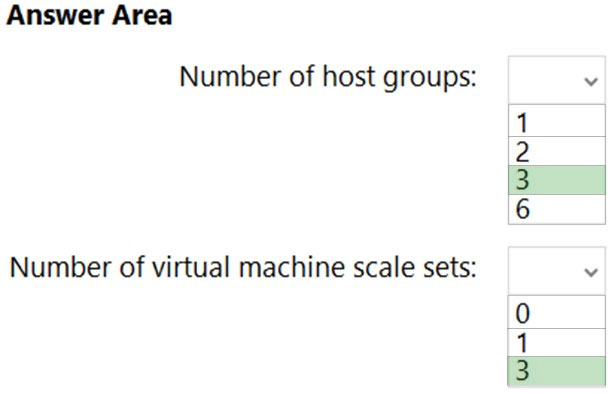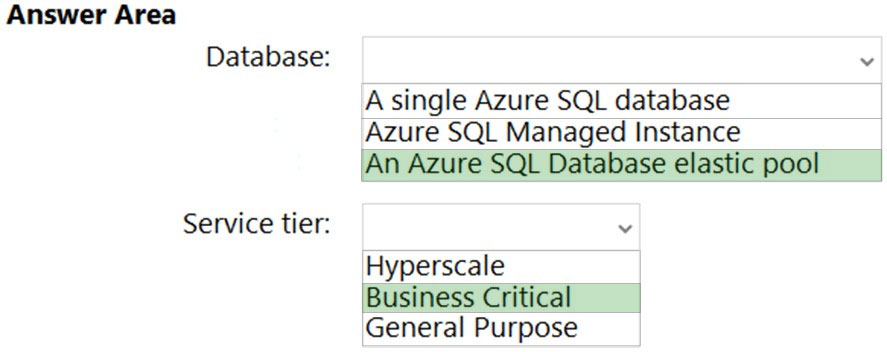AZ-305 Practice Questions Free – 50 Exam-Style Questions to Sharpen Your Skills
Are you preparing for the AZ-305 certification exam? Kickstart your success with our AZ-305 Practice Questions Free – a carefully selected set of 50 real exam-style questions to help you test your knowledge and identify areas for improvement.
Practicing with AZ-305 practice questions free gives you a powerful edge by allowing you to:
- Understand the exam structure and question formats
- Discover your strong and weak areas
- Build the confidence you need for test day success
Below, you will find 50 free AZ-305 practice questions designed to match the real exam in both difficulty and topic coverage. They’re ideal for self-assessment or final review. You can click on each Question to explore the details.
HOTSPOT - You plan to deploy a containerized web-app that will be hosted in five Azure Kubernetes Service (AKS) clusters. Each cluster will be hosted in a different Azure region. You need to provide access to the app from the internet. The solution must meet the following requirements: • Incoming HTTPS requests must be routed to the cluster that has the lowest network latency. • HTTPS traffic to individual pods must be routed via an ingress controller. • In the event of an AKS cluster outage, failover time must be minimized. What should you include in the solution? To answer, select the appropriate options in the answer area. NOTE: Each correct selection is worth one point.
Overview - Fabrikam, Inc. is an engineering company that has offices throughout Europe. The company has a main office in London and three branch offices in Amsterdam, Berlin, and Rome. Existing Environment: Active Directory Environment The network contains two Active Directory forests named corp.fabrikam.com and rd.fabrikam.com. There are no trust relationships between the forests. Corp.fabrikam.com is a production forest that contains identities used for internal user and computer authentication. Rd.fabrikam.com is used by the research and development (R&D) department only. The R&D department is restricted to using on-premises resources only. Existing Environment: Network Infrastructure Each office contains at least one domain controller from the corp.fabrikam.com domain. The main office contains all the domain controllers for the rd.fabrikam.com forest. All the offices have a high-speed connection to the internet. An existing application named WebApp1 is hosted in the data center of the London office. WebApp1 is used by customers to place and track orders. WebApp1 has a web tier that uses Microsoft Internet Information Services (IIS) and a database tier that runs Microsoft SQL Server 2016. The web tier and the database tier are deployed to virtual machines that run on Hyper-V. The IT department currently uses a separate Hyper-V environment to test updates to WebApp1. Fabrikam purchases all Microsoft licenses through a Microsoft Enterprise Agreement that includes Software Assurance. Existing Environment: Problem Statements The use of WebApp1 is unpredictable. At peak times, users often report delays. At other times, many resources for WebApp1 are underutilized. Requirements: Planned Changes - Fabrikam plans to move most of its production workloads to Azure during the next few years, including virtual machines that rely on Active Directory for authentication. As one of its first projects, the company plans to establish a hybrid identity model, facilitating an upcoming Microsoft 365 deployment. All R&D operations will remain on-premises. Fabrikam plans to migrate the production and test instances of WebApp1 to Azure. Requirements: Technical Requirements Fabrikam identifies the following technical requirements: Website content must be easily updated from a single point. User input must be minimized when provisioning new web app instances. Whenever possible, existing on-premises licenses must be used to reduce cost. Users must always authenticate by using their corp.fabrikam.com UPN identity. Any new deployments to Azure must be redundant in case an Azure region fails. Whenever possible, solutions must be deployed to Azure by using the Standard pricing tier of Azure App Service. An email distribution group named IT Support must be notified of any issues relating to the directory synchronization services. In the event that a link fails between Azure and the on-premises network, ensure that the virtual machines hosted in Azure can authenticate to Active Directory. Directory synchronization between Azure Active Directory (Azure AD) and corp.fabrikam.com must not be affected by a link failure between Azure and the on- premises network. Requirements: Database Requirements Fabrikam identifies the following database requirements: Database metrics for the production instance of WebApp1 must be available for analysis so that database administrators can optimize the performance settings. To avoid disrupting customer access, database downtime must be minimized when databases are migrated. Database backups must be retained for a minimum of seven years to meet compliance requirements. Requirements: Security Requirements Fabrikam identifies the following security requirements: Company information including policies, templates, and data must be inaccessible to anyone outside the company. Users on the on-premises network must be able to authenticate to corp.fabrikam.com if an internet link fails. Administrators must be able authenticate to the Azure portal by using their corp.fabrikam.com credentials. All administrative access to the Azure portal must be secured by using multi-factor authentication (MFA). The testing of WebApp1 updates must not be visible to anyone outside the company. You need to recommend a solution to meet the database retention requirements. What should you recommend?
A. Configure a long-term retention policy for the database.
B. Configure Azure Site Recovery.
C. Use automatic Azure SQL Database backups.
D. Configure geo-replication of the database.
HOTSPOT - You plan to create an Azure environment that will contain a root management group and 10 child management groups. Each child management group will contain five Azure subscriptions. You plan to have between 10 and 30 resource groups in each subscription. You need to design an Azure governance solution. The solution must meet the following requirements: ✑ Use Azure Blueprints to control governance across all the subscriptions and resource groups. ✑ Ensure that Blueprints-based configurations are consistent across all the subscriptions and resource groups. ✑ Minimize the number of blueprint definitions and assignments. What should you include in the solution? To answer, select the appropriate options in the answer area. NOTE: Each correct selection is worth one point. Hot Area:
You have an Azure subscription. You need to recommend an Azure Kubernetes Service (AKS) solution that will use Linux nodes. The solution must meet the following requirements: ✑ Minimize the time it takes to provision compute resources during scale-out operations. ✑ Support autoscaling of Linux containers. ✑ Minimize administrative effort. Which scaling option should you recommend?
A. horizontal pod autoscaler
B. cluster autoscaler
C. virtual nodes
D. Virtual Kubelet
You need to design a highly available Azure SQL database that meets the following requirements: • Failover between replicas of the database must occur without any data loss. • The database must remain available in the event of a zone outage. • Costs must be minimized. Which deployment option should you use?
A. Azure SQL Database Standard
B. Azure SQL Managed Instance Business Critical
C. Azure SQL Database Serverless
D. Azure SQL Database Premium
You need to recommend a solution to generate a monthly report of all the new Azure Resource Manager (ARM) resource deployments in your Azure subscription. What should you include in the recommendation?
A. Application Insights
B. Azure Analysis Services
C. Azure Advisor
D. Azure Log Analytics
You have an Azure subscription. You need to deploy an Azure Kubernetes Service (AKS) solution that will use Windows Server 2019 nodes. The solution must meet the following requirements: • Minimize the time it takes to provision compute resources during scale-out operations. • Support autoscaling of Windows Server containers. Which scaling option should you recommend?
A. horizontal pod autoscaler
B. Virtual nodes
C. Kubernetes version 1.20.2 or newer
D. cluster autoscaler
DRAG DROP - You plan to use Azure Storage to store data assets. You need to identify the procedure to fail over a general-purpose v2 account as part of a disaster recovery plan. The solution must meet the following requirements: • Apps must be able to access the storage account after a failover. • You must be able to fail back the storage account to the original location. • Downtime must be minimized. Which three actions should you perform in sequence? To answer, move the appropriate actions from the list of actions to the answer area and arrange them in the correct order.
You plan to move a web app named App1 from an on-premises datacenter to Azure. App1 depends on a custom COM component that is installed on the host server. You need to recommend a solution to host App1 in Azure. The solution must meet the following requirements: ✑ App1 must be available to users if an Azure datacenter becomes unavailable. ✑ Costs must be minimized. What should you include in the recommendation?
A. In two Azure regions, deploy a load balancer and a web app.
B. In two Azure regions, deploy a load balancer and a virtual machine scale set.
C. Deploy a load balancer and a virtual machine scale set across two availability zones.
D. In two Azure regions, deploy an Azure Traffic Manager profile and a web app.
Overview - Contoso, Ltd. is a research company that has a main office in Montreal. Existing Environment: Technical Environment The on-premises network contains a single Active Directory domain named contoso.com. Contoso has a single Azure subscription. Existing Environment: Business Partnerships Contoso has a business partnership with Fabrikam, Inc. Fabrikam users access some Contoso applications over the internet by using Azure Active Directory (Azure AD) guest accounts. Requirements: Planned Changes - Contoso plans to deploy two applications named App1 and App2 to Azure. Requirements: App1 - App1 will be a Python web app hosted in Azure App Service that requires a Linux runtime. Users from Contoso and Fabrikam will access App1. App1 will access several services that require third-party credentials and access strings. The credentials and access strings are stored in Azure Key Vault. App1 will have six instances: three in the East US Azure region and three in the West Europe Azure region. App1 has the following data requirements: Each instance will write data to a data store in the same availability zone as the instance. Data written by any App1 instance must be visible to all App1 instances. App1 will only be accessible from the internet. App1 has the following connection requirements: Connections to App1 must pass through a web application firewall (WAF). Connections to App1 must be active-active load balanced between instances. All connections to App1 from North America must be directed to the East US region. All other connections must be directed to the West Europe region. Every hour, you will run a maintenance task by invoking a PowerShell script that copies files from all the App1 instances. The PowerShell script will run from a central location. Requirements: App2 - App2 will be a .NET app hosted in App Service that requires a Windows runtime. App2 has the following file storage requirements: Save files to an Azure Storage account. Replicate files to an on-premises location. Ensure that on-premises clients can read the files over the LAN by using the SMB protocol. You need to monitor App2 to analyze how long it takes to perform different transactions within the application. The solution must not require changes to the application code. Application Development Requirements Application developers will constantly develop new versions of App1 and App2. The development process must meet the following requirements: A staging instance of a new application version must be deployed to the application host before the new version is used in production. After testing the new version, the staging version of the application will replace the production version. The switch to the new application version from staging to production must occur without any downtime of the application. Identity Requirements - Contoso identifies the following requirements for managing Fabrikam access to resources: Every month, an account manager at Fabrikam must review which Fabrikam users have access permissions to App1. Accounts that no longer need permissions must be removed as guests. The solution must minimize development effort. Security Requirement - All secrets used by Azure services must be stored in Azure Key Vault. Services that require credentials must have the credentials tied to the service instance. The credentials must NOT be shared between services. DRAG DROP - You need to recommend a solution that meets the file storage requirements for App2. What should you deploy to the Azure subscription and the on-premises network? To answer, drag the appropriate services to the correct locations. Each service may be used once, more than once, or not at all. You may need to drag the split bar between panes or scroll to view content. NOTE: Each correct selection is worth one point. Select and Place:
HOTSPOT - You need to recommend a solution to integrate Azure Cosmos DB and Azure Synapse. The solution must meet the following requirements: • Traffic from an Azure Synapse workspace to the Azure Cosmos DB account must be sent via the Microsoft backbone network. • Traffic from the Azure Synapse workspace to the Azure Cosmos DB account must NOT be routed over the internet. • Implementation effort must be minimized. What should you include in the recommendation? To answer, select the appropriate options in the answer area. NOTE: Each correct selection is worth one point.
HOTSPOT - You have an on-premises file server that stores 2 TB of data files. You plan to move the data files to Azure Blob Storage in the West Europe Azure region. You need to recommend a storage account type to store the data files and a replication solution for the storage account. The solution must meet the following requirements: ✑ Be available if a single Azure datacenter fails. ✑ Support storage tiers. ✑ Minimize cost. What should you recommend? To answer, select the appropriate options in the answer area. NOTE: Each correct selection is worth one point. Hot Area:
HOTSPOT - Your company, named Contoso, Ltd., has an Azure subscription that contains the following resources: • An Azure Synapse Analytics workspace named contosoworkspace1 • An Azure Data Lake Storage account named contosolake1 • An Azure SQL database named contososql1 The product data of Contoso is copied from contososql1 to contosolake1. Contoso has a partner company named Fabrikam Inc. Fabrikam has an Azure subscription that contains the following resources: • A virtual machine named FabrikamVM1 that runs Microsoft SQL Server 2019 • An Azure Storage account named fabrikamsa1 Contoso plans to upload the research data on FabrikamVM1 to contosolake1. During the upload, the research data must be transformed to the data formats used by Contoso. The data in contosolake1 will be analyzed by using contosoworkspace1. You need to recommend a solution that meets the following requirements: • Upload and transform the FabrikamVM1 research data. • Provide Fabrikam with restricted access to snapshots of the data in contosoworkspace1. What should you recommend for each requirement? To answer, select the appropriate options in the answer area. NOTE: Each correct selection is worth one point.
You have an Azure AD tenant named contoso.com that has a security group named Group1. Group1 is configured for assigned memberships. Group1 has 50 members, including 20 guest users. You need to recommend a solution for evaluating the membership of Group1. The solution must meet the following requirements: • The evaluation must be repeated automatically every three months. • Every member must be able to report whether they need to be in Group1. • Users who report that they do not need to be in Group1 must be removed from Group1 automatically. • Users who do not report whether they need to be in Group1 must be removed from Group1 automatically. What should you include in the recommendation?
A. Implement Azure AD Identity Protection.
B. Change the Membership type of Group1 to Dynamic User.
C. Create an access review.
D. Implement Azure AD Privileged Identity Management (PIM).
Your company has offices in North America and Europe. You plan to migrate to Azure. You need to recommend a networking solution for the new Azure infrastructure. The solution must meet the following requirements: • The Point-to-Site (P2S) VPN connections of mobile users must connect automatically to the closest Azure region. • The offices in each region must connect to their local Azure region by using an ExpressRoute circuit. • Transitive routing between virtual networks and on-premises networks must be supported. • The network traffic between virtual networks must be filtered by using FQDNs. What should you include in the recommendation?
A. Azure Virtual WAN with a secured virtual hub
B. virtual network peering and application security groups
C. virtual network gateways and network security groups (NSGs)
D. Azure Route Server and Azure Network Function Manager
HOTSPOT - You have an Azure subscription. You need to deploy a relational database. The solution must meet the following requirements: • Support multiple read-only replicas. • Automatically load balance read-only requests across all the read-only replicas. • Minimize administrative effort What should you use? To answer, select the appropriate options in the answer area. NOTE: Each correct selection is worth one point.
Note: This question is part of a series of questions that present the same scenario. Each question in the series contains a unique solution that might meet the stated goals. Some question sets might have more than one correct solution, while others might not have a correct solution. After you answer a question in this section, you will NOT be able to return to it. As a result, these questions will not appear in the review screen. Your company deploys several virtual machines on-premises and to Azure. ExpressRoute is deployed and configured for on-premises to Azure connectivity. Several virtual machines exhibit network connectivity issues. You need to analyze the network traffic to identify whether packets are being allowed or denied to the virtual machines. Solution: Install and configure the Azure Monitoring agent and the Dependency Agent on all the virtual machines. Use VM insights in Azure Monitor to analyze the network traffic. Does this meet the goal?
A. Yes
B. No
Note: This question is part of a series of questions that present the same scenario. Each question in the series contains a unique solution that might meet the stated goals. Some question sets might have more than one correct solution, while others might not have a correct solution. After you answer a question in this section, you will NOT be able to return to it. As a result, these questions will not appear in the review screen. Your company plans to deploy various Azure App Service instances that will use Azure SQL databases. The App Service instances will be deployed at the same time as the Azure SQL databases. The company has a regulatory requirement to deploy the App Service instances only to specific Azure regions. The resources for the App Service instances must reside in the same region. You need to recommend a solution to meet the regulatory requirement. Solution: You recommend using an Azure Policy initiative to enforce the location. Does this meet the goal?
A. Yes
B. No
You need to recommend a solution to generate a monthly report of all the new Azure Resource Manager (ARM) resource deployments in your Azure subscription. What should you include in the recommendation?
A. Azure Log Analytics
B. Azure Arc
C. Azure Analysis Services
D. Application Insights
You have an Azure Active Directory (Azure AD) tenant that syncs with an on-premises Active Directory domain. You have an internal web app named WebApp1 that is hosted on-premises. WebApp1 uses Integrated Windows authentication. Some users work remotely and do NOT have VPN access to the on-premises network. You need to provide the remote users with single sign-on (SSO) access to WebApp1. Which two features should you include in the solution? Each correct answer presents part of the solution. NOTE: Each correct selection is worth one point.
A. Azure AD Application Proxy
B. Azure AD Privileged Identity Management (PIM)
C. Conditional Access policies
D. Azure Arc
E. Azure AD enterprise applications
F. Azure Application Gateway
You need to recommend a solution to generate a monthly report of all the new Azure Resource Manager (ARM) resource deployments in your Azure subscription. What should you include in the recommendation?
A. Azure Log Analytics
B. Azure Analysis Services
C. Azure Monitor metrics
D. Azure Monitor action groups
HOTSPOT - You plan to use Azure SQL as a database platform. You need to recommend an Azure SQL product and service tier that meets the following requirements: • Automatically scales compute resources based on the workload demand • Provides per second billing What should you recommend? To answer, select the appropriate options in the answer area. NOTE: Each correct selection is worth one point.
Overview - Contoso, Ltd. is a research company that has a main office in Montreal. Existing Environment - Technical Environment - The on-premises network contains a single Active Directory domain named contoso.com. Contoso has a single Azure subscription. Business Partnerships - Contoso has a business partnership with Fabrikam, Inc. Fabrikam users access some Contoso applications over the internet by using Azure Active Directory (Azure AD) guest accounts. Requirements - Planned Changes - Contoso plans to deploy two applications named App1 and App2 to Azure. App1 - App1 will be a Python web app hosted in Azure App Service that requires a Linux runtime. Users from Contoso and Fabrikam will access App1. App1 will access several services that require third-party credentials and access strings. The credentials and access strings are stored in Azure Key Vault. App1 will have six instances: three in the East US Azure region and three in the West Europe Azure region. App1 has the following data requirements: Each instance will write data to a data store in the same availability zone as the instance. Data written by any App1 instance must be visible to all App1 instances. App1 will only be accessible from the internet. App1 has the following connection requirements: Connections to App1 must pass through a web application firewall (WAF). Connections to App1 must be active-active load balanced between instances. All connections to App1 from North America must be directed to the East US region. All other connections must be directed to the West Europe region. Every hour, you will run a maintenance task by invoking a PowerShell script that copies files from all the App1 instances. The PowerShell script will run from a central location. App2 - App2 will be a .NET app hosted in App Service that requires a Windows runtime. App2 has the following file storage requirements: Save files to an Azure Storage account. Replicate files to an on-premises location. Ensure that on-premises clients can read the files over the LAN by using the SMB protocol. You need to monitor App2 to analyze how long it takes to perform different transactions within the application. The solution must not require changes to the application code. Application Development Requirements Application developers will constantly develop new versions of App1 and App2. The development process must meet the following requirements: A staging instance of a new application version must be deployed to the application host before the new version is used in production. After testing the new version, the staging version of the application will replace the production version.The switch to the new application version from staging to production must occur without any downtime of the application. Identity Requirements - Contoso identifies the following requirements for managing Fabrikam access to resources: Every month, an account manager at Fabrikam must review which Fabrikam users have access permissions to App1. Accounts that no longer need permissions must be removed as guests. The solution must minimize development effort. Security Requirement - All secrets used by Azure services must be stored in Azure Key Vault. Services that require credentials must have the credentials tied to the service instance. The credentials must NOT be shared between services. You need to recommend a solution for the App1 maintenance task. The solution must minimize costs. What should you include in the recommendation?
A. an Azure logic app
B. an Azure function
C. an Azure virtual machine
D. an App Service WebJob
You have a .NET web service named Service1 that performs the following tasks: ✑ Reads and writes temporary files to the local file system. ✑ Writes to the Application event log. You need to recommend a solution to host Service1 in Azure. The solution must meet the following requirements: ✑ Minimize maintenance overhead. ✑ Minimize costs. What should you include in the recommendation?
A. an Azure App Service web app
B. an Azure virtual machine scale set
C. an App Service Environment (ASE)
D. an Azure Functions app
HOTSPOT - You plan to deploy the backup policy shown in the following exhibit.Use the drop-down menus to select the answer choice that completes each statement based on the information presented in the graphic. NOTE: Each correct selection is worth one point. Hot Area:
You plan to deploy an Azure SQL database that will store Personally Identifiable Information (PII). You need to ensure that only privileged users can view the PII. What should you include in the solution?
A. dynamic data masking
B. role-based access control (RBAC)
C. Data Discovery & Classification
D. Transparent Data Encryption (TDE)
Overview - Litware, Inc. is a medium-sized finance company that has a main office in Boston. Existing Environment - Identity Environment - The network contains an Active Directory forest named litware.com that is linked to an Azure Active Directory (Azure AD) tenant named litware.com. All users have Azure Active Directory Premium P2 licenses. Litware has a second Azure AD tenant named dev.litware.com that is used as a development environment. The litware.com tenant has a Conditional Access policy named Capolicy1. Capolicy1 requires that when users manage the Azure subscription for a production environment by using the Azure portal, they must connect from a hybrid Azure AD-joined device. Azure Environment - Litware has 10 Azure subscriptions that are linked to the Litware.com tenant and five Azure subscriptions that are linked to the dev.litware.com tenant. All the subscriptions are in an Enterprise Agreement (EA). The litware.com tenant contains a custom Azure role-based access control (Azure RBAC) role named Role1 that grants the DataActions read permission to the blobs and files in Azure Storage. On-Premises Environment - The on-premises network of Litware contains the resources shown in the following table.Network Environment - Litware has ExpressRoute connectivity to Azure. Planned Changes and Requirements Planned Changes - Litware plans to implement the following changes: Migrate DB1 and DB2 to Azure. Migrate App1 to Azure virtual machines. Migrate the external storage used by App1 to Azure Storage. Deploy the Azure virtual machines that will host App1 to Azure dedicated hosts.
Authentication and Authorization Requirements Litware identifies the following authentication and authorization requirements: Only users that manage the production environment by using the Azure portal must connect from a hybrid Azure AD-joined device and authenticate by using Azure Multi-Factor Authentication (MFA). The Network Contributor built-in RBAC role must be used to grant permissions to the network administrators for all the virtual networks in all the Azure subscriptions. To access the resources in Azure, App1 must use the managed identity of the virtual machines that will host the app. RBAC roles must be applied to management groups. Resiliency Requirements - Litware identifies the following resiliency requirements: Once migrated to Azure, DB1 and DB2 must meet the following requirements: - Maintain availability if two availability zones in the local Azure region fail. - Fail over automatically. - Minimize I/O latency. App1 must meet the following requirements: - Be hosted in an Azure region that supports availability zones. - Be hosted on Azure virtual machines that support automatic scaling. - Maintain availability if two availability zones in the local Azure region fail. Security and Compliance Requirements Litware identifies the following security and compliance requirements: Once App1 is migrated to Azure, you must ensure that new data can be written to the app, and the modification of new and existing data is prevented for a period of three years. On-premises users and services must be able to access the Azure Storage account that will host the data in App1. Access to the public endpoint of the Azure Storage account that will host the App1 data must be prevented. All Azure SQL databases in the production environment must have Transparent Data Encryption (TDE) enabled. App1 must NOT share physical hardware with other workloads. Business Requirements - Litware identifies the following business requirements: Minimize administrative effort. Minimize costs.
You need to implement the Azure RBAC role assignments for the Network Contributor role. The solution must meet the authentication and authorization requirements.
What is the minimum number of assignments that you must use?
A. 1
B. 2
C. 5
D. 10
E. 15
Overview - Fabrikam, Inc. is an engineering company that has offices throughout Europe. The company has a main office in London and three branch offices in Amsterdam, Berlin, and Rome. Existing Environment: Active Directory Environment The network contains two Active Directory forests named corp.fabrikam.com and rd.fabrikam.com. There are no trust relationships between the forests. Corp.fabrikam.com is a production forest that contains identities used for internal user and computer authentication. Rd.fabrikam.com is used by the research and development (R&D) department only. The R&D department is restricted to using on-premises resources only. Existing Environment: Network Infrastructure Each office contains at least one domain controller from the corp.fabrikam.com domain. The main office contains all the domain controllers for the rd.fabrikam.com forest. All the offices have a high-speed connection to the internet. An existing application named WebApp1 is hosted in the data center of the London office. WebApp1 is used by customers to place and track orders. WebApp1 has a web tier that uses Microsoft Internet Information Services (IIS) and a database tier that runs Microsoft SQL Server 2016. The web tier and the database tier are deployed to virtual machines that run on Hyper-V. The IT department currently uses a separate Hyper-V environment to test updates to WebApp1. Fabrikam purchases all Microsoft licenses through a Microsoft Enterprise Agreement that includes Software Assurance. Existing Environment: Problem Statements The use of WebApp1 is unpredictable. At peak times, users often report delays. At other times, many resources for WebApp1 are underutilized. Requirements: Planned Changes - Fabrikam plans to move most of its production workloads to Azure during the next few years, including virtual machines that rely on Active Directory for authentication. As one of its first projects, the company plans to establish a hybrid identity model, facilitating an upcoming Microsoft 365 deployment. All R&D operations will remain on-premises. Fabrikam plans to migrate the production and test instances of WebApp1 to Azure. Requirements: Technical Requirements Fabrikam identifies the following technical requirements: Website content must be easily updated from a single point. User input must be minimized when provisioning new web app instances. Whenever possible, existing on-premises licenses must be used to reduce cost. Users must always authenticate by using their corp.fabrikam.com UPN identity. Any new deployments to Azure must be redundant in case an Azure region fails. Whenever possible, solutions must be deployed to Azure by using the Standard pricing tier of Azure App Service. An email distribution group named IT Support must be notified of any issues relating to the directory synchronization services. In the event that a link fails between Azure and the on-premises network, ensure that the virtual machines hosted in Azure can authenticate to Active Directory. Directory synchronization between Azure Active Directory (Azure AD) and corp.fabrikam.com must not be affected by a link failure between Azure and the on- premises network. Requirements: Database Requirements Fabrikam identifies the following database requirements: Database metrics for the production instance of WebApp1 must be available for analysis so that database administrators can optimize the performance settings. To avoid disrupting customer access, database downtime must be minimized when databases are migrated. Database backups must be retained for a minimum of seven years to meet compliance requirements. Requirements: Security Requirements Fabrikam identifies the following security requirements: Company information including policies, templates, and data must be inaccessible to anyone outside the company. Users on the on-premises network must be able to authenticate to corp.fabrikam.com if an internet link fails. Administrators must be able authenticate to the Azure portal by using their corp.fabrikam.com credentials. All administrative access to the Azure portal must be secured by using multi-factor authentication (MFA). The testing of WebApp1 updates must not be visible to anyone outside the company. HOTSPOT - You design a solution for the web tier of WebApp1 as shown in the exhibit.For each of the following statements, select Yes if the statement is true. Otherwise, select No. NOTE: Each correct selection is worth one point. Hot Area:
You need to recommend a data storage solution that meets the following requirements: ✑ Ensures that applications can access the data by using a REST connection ✑ Hosts 20 independent tables of varying sizes and usage patterns ✑ Automatically replicates the data to a second Azure region ✑ Minimizes costs What should you recommend?
A. an Azure SQL Database elastic pool that uses active geo-replication
B. tables in an Azure Storage account that use geo-redundant storage (GRS)
C. tables in an Azure Storage account that use read-access geo-redundant storage (RA-GRS)
D. an Azure SQL database that uses active geo-replication
Overview - Contoso, Ltd. is a research company that has a main office in Montreal. Existing Environment: Technical Environment The on-premises network contains a single Active Directory domain named contoso.com. Contoso has a single Azure subscription. Existing Environment: Business Partnerships Contoso has a business partnership with Fabrikam, Inc. Fabrikam users access some Contoso applications over the internet by using Azure Active Directory (Azure AD) guest accounts. Requirements: Planned Changes - Contoso plans to deploy two applications named App1 and App2 to Azure. Requirements: App1 - App1 will be a Python web app hosted in Azure App Service that requires a Linux runtime. Users from Contoso and Fabrikam will access App1. App1 will access several services that require third-party credentials and access strings. The credentials and access strings are stored in Azure Key Vault. App1 will have six instances: three in the East US Azure region and three in the West Europe Azure region. App1 has the following data requirements: Each instance will write data to a data store in the same availability zone as the instance. Data written by any App1 instance must be visible to all App1 instances. App1 will only be accessible from the internet. App1 has the following connection requirements: Connections to App1 must pass through a web application firewall (WAF). Connections to App1 must be active-active load balanced between instances. All connections to App1 from North America must be directed to the East US region. All other connections must be directed to the West Europe region. Every hour, you will run a maintenance task by invoking a PowerShell script that copies files from all the App1 instances. The PowerShell script will run from a central location. Requirements: App2 - App2 will be a .NET app hosted in App Service that requires a Windows runtime. App2 has the following file storage requirements: Save files to an Azure Storage account. Replicate files to an on-premises location. Ensure that on-premises clients can read the files over the LAN by using the SMB protocol. You need to monitor App2 to analyze how long it takes to perform different transactions within the application. The solution must not require changes to the application code. Application Development Requirements Application developers will constantly develop new versions of App1 and App2. The development process must meet the following requirements: A staging instance of a new application version must be deployed to the application host before the new version is used in production. After testing the new version, the staging version of the application will replace the production version. The switch to the new application version from staging to production must occur without any downtime of the application. Identity Requirements - Contoso identifies the following requirements for managing Fabrikam access to resources: Every month, an account manager at Fabrikam must review which Fabrikam users have access permissions to App1. Accounts that no longer need permissions must be removed as guests. The solution must minimize development effort. Security Requirement - All secrets used by Azure services must be stored in Azure Key Vault. Services that require credentials must have the credentials tied to the service instance. The credentials must NOT be shared between services. HOTSPOT - You are evaluating whether to use Azure Traffic Manager and Azure Application Gateway to meet the connection requirements for App1. What is the minimum numbers of instances required for each service? To answer, select the appropriate options in the answer area. NOTE: Each correct selection is worth one point. Hot Area:
Note: This question is part of a series of questions that present the same scenario. Each question in the series contains a unique solution that might meet the stated goals. Some question sets might have more than one correct solution, while others might not have a correct solution. After you answer a question in this section, you will NOT be able to return to it. As a result, these questions will not appear in the review screen. You need to deploy resources to host a stateless web app in an Azure subscription. The solution must meet the following requirements: ✑ Provide access to the full .NET framework. ✑ Provide redundancy if an Azure region fails. ✑ Grant administrators access to the operating system to install custom application dependencies. Solution: You deploy two Azure virtual machines to two Azure regions, and you deploy an Azure Application Gateway. Does this meet the goal?
A. Yes
B. No
HOTSPOT - You have five Azure subscriptions. Each subscription is linked to a separate Azure AD tenant and contains virtual machines that run Windows Server 2022. You plan to collect Windows security events from the virtual machines and send them to a single Log Analytics workspace. You need to recommend a solution that meets the following requirements: • Collects event logs from multiple subscriptions • Supports the use of data collection rules (DCRs) to define which events to collect What should you recommend for each requirement? To answer, select the appropriate options in the answer area. NOTE: Each correct selection is worth one point.
DRAG DROP - You have an on-premises network that uses an IP address space of 172.16.0.0/16. You plan to deploy 30 virtual machines to a new Azure subscription. You identify the following technical requirements: ✑ All Azure virtual machines must be placed on the same subnet named Subnet1. ✑ All the Azure virtual machines must be able to communicate with all on-premises servers. ✑ The servers must be able to communicate between the on-premises network and Azure by using a site-to-site VPN. You need to recommend a subnet design that meets the technical requirements. What should you include in the recommendation? To answer, drag the appropriate network addresses to the correct subnets. Each network address may be used once, more than once, or not at all. You may need to drag the split bar between panes or scroll to view content. NOTE: Each correct selection is worth one point. Select and Place:
You have an Azure virtual machine named VM1 that runs Windows Server 2019 and contains 500 GB of data files. You are designing a solution that will use Azure Data Factory to transform the data files, and then load the files to Azure Data Lake Storage. What should you deploy on VM1 to support the design?
A. the On-premises data gateway
B. the Azure Pipelines agent
C. the self-hosted integration runtime
D. the Azure File Sync agent
You have an Azure subscription that contains 1,000 resources. You need to generate compliance reports for the subscription. The solution must ensure that the resources can be grouped by department. What should you use to organize the resources?
A. application groups and quotas
B. Azure Policy and tags
C. administrative units and Azure Lighthouse
D. resource groups and role assignments
You need to design a highly available Azure SQL database that meets the following requirements: • Failover between replicas of the database must occur without any data loss. • The database must remain available in the event of a zone outage. • Costs must be minimized. Which deployment option should you use?
A. Azure SQL Database Serverless
B. Azure SQL Managed Instance General Purpose
C. Azure SQL Database Basic
D. Azure SQL Database Business Critical
Overview - Contoso, Ltd. is a research company that has a main office in Montreal. Existing Environment: Technical Environment The on-premises network contains a single Active Directory domain named contoso.com. Contoso has a single Azure subscription. Existing Environment: Business Partnerships Contoso has a business partnership with Fabrikam, Inc. Fabrikam users access some Contoso applications over the internet by using Azure Active Directory (Azure AD) guest accounts. Requirements: Planned Changes - Contoso plans to deploy two applications named App1 and App2 to Azure. Requirements: App1 - App1 will be a Python web app hosted in Azure App Service that requires a Linux runtime. Users from Contoso and Fabrikam will access App1. App1 will access several services that require third-party credentials and access strings. The credentials and access strings are stored in Azure Key Vault. App1 will have six instances: three in the East US Azure region and three in the West Europe Azure region. App1 has the following data requirements: Each instance will write data to a data store in the same availability zone as the instance. Data written by any App1 instance must be visible to all App1 instances. App1 will only be accessible from the internet. App1 has the following connection requirements: Connections to App1 must pass through a web application firewall (WAF). Connections to App1 must be active-active load balanced between instances. All connections to App1 from North America must be directed to the East US region. All other connections must be directed to the West Europe region. Every hour, you will run a maintenance task by invoking a PowerShell script that copies files from all the App1 instances. The PowerShell script will run from a central location. Requirements: App2 - App2 will be a .NET app hosted in App Service that requires a Windows runtime. App2 has the following file storage requirements: Save files to an Azure Storage account. Replicate files to an on-premises location. Ensure that on-premises clients can read the files over the LAN by using the SMB protocol. You need to monitor App2 to analyze how long it takes to perform different transactions within the application. The solution must not require changes to the application code. Application Development Requirements Application developers will constantly develop new versions of App1 and App2. The development process must meet the following requirements: A staging instance of a new application version must be deployed to the application host before the new version is used in production. After testing the new version, the staging version of the application will replace the production version. The switch to the new application version from staging to production must occur without any downtime of the application. Identity Requirements - Contoso identifies the following requirements for managing Fabrikam access to resources: Every month, an account manager at Fabrikam must review which Fabrikam users have access permissions to App1. Accounts that no longer need permissions must be removed as guests. The solution must minimize development effort. Security Requirement - All secrets used by Azure services must be stored in Azure Key Vault. Services that require credentials must have the credentials tied to the service instance. The credentials must NOT be shared between services. HOTSPOT - What should you implement to meet the identity requirements? To answer, select the appropriate options in the answer area. NOTE: Each correct selection is worth one point. Hot Area:
HOTSPOT - You plan to deploy an Azure web app named App1 that will use Azure Active Directory (Azure AD) authentication. App1 will be accessed from the internet by the users at your company. All the users have computers that run Windows 10 and are joined to Azure AD. You need to recommend a solution to ensure that the users can connect to App1 without being prompted for authentication and can access App1 only from company-owned computers. What should you recommend for each requirement? To answer, select the appropriate options in the answer area. NOTE: Each correct selection is worth one point. Hot Area:
Overview - Litware, Inc. is a medium-sized finance company that has a main office in Boston. Existing Environment - Identity Environment - The network contains an Active Directory forest named litware.com that is linked to an Azure Active Directory (Azure AD) tenant named litware.com. All users have Azure Active Directory Premium P2 licenses. Litware has a second Azure AD tenant named dev.litware.com that is used as a development environment. The litware.com tenant has a Conditional Access policy named Capolicy1. Capolicy1 requires that when users manage the Azure subscription for a production environment by using the Azure portal, they must connect from a hybrid Azure AD-joined device. Azure Environment - Litware has 10 Azure subscriptions that are linked to the Litware.com tenant and five Azure subscriptions that are linked to the dev.litware.com tenant. All the subscriptions are in an Enterprise Agreement (EA). The litware.com tenant contains a custom Azure role-based access control (Azure RBAC) role named Role1 that grants the DataActions read permission to the blobs and files in Azure Storage. On-Premises Environment - The on-premises network of Litware contains the resources shown in the following table.Network Environment - Litware has ExpressRoute connectivity to Azure. Planned Changes and Requirements Planned Changes - Litware plans to implement the following changes: Migrate DB1 and DB2 to Azure. Migrate App1 to Azure virtual machines. Migrate the external storage used by App1 to Azure Storage. Deploy the Azure virtual machines that will host App1 to Azure dedicated hosts.
Authentication and Authorization Requirements Litware identifies the following authentication and authorization requirements: Only users that manage the production environment by using the Azure portal must connect from a hybrid Azure AD-joined device and authenticate by using Azure Multi-Factor Authentication (MFA). The Network Contributor built-in RBAC role must be used to grant permissions to the network administrators for all the virtual networks in all the Azure subscriptions. To access the resources in Azure, App1 must use the managed identity of the virtual machines that will host the app. RBAC roles must be applied to management groups. Resiliency Requirements - Litware identifies the following resiliency requirements: Once migrated to Azure, DB1 and DB2 must meet the following requirements: - Maintain availability if two availability zones in the local Azure region fail. - Fail over automatically. - Minimize I/O latency. App1 must meet the following requirements: - Be hosted in an Azure region that supports availability zones. - Be hosted on Azure virtual machines that support automatic scaling. - Maintain availability if two availability zones in the local Azure region fail. Security and Compliance Requirements Litware identifies the following security and compliance requirements: Once App1 is migrated to Azure, you must ensure that new data can be written to the app, and the modification of new and existing data is prevented for a period of three years. On-premises users and services must be able to access the Azure Storage account that will host the data in App1. Access to the public endpoint of the Azure Storage account that will host the App1 data must be prevented. All Azure SQL databases in the production environment must have Transparent Data Encryption (TDE) enabled. App1 must NOT share physical hardware with other workloads. Business Requirements - Litware identifies the following business requirements: Minimize administrative effort. Minimize costs.
HOTSPOT –
You plan to migrate App1 to Azure.
You need to recommend a high-availability solution for App1. The solution must meet the resiliency requirements.
What should you include in the recommendation? To answer, select the appropriate options in the answer area.
NOTE: Each correct selection is worth one point.
Hot Area:
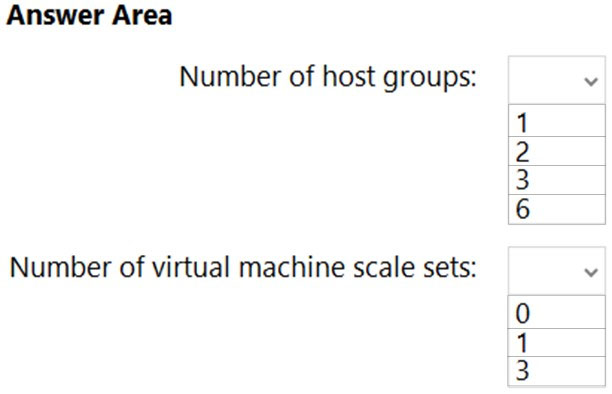
You have an Azure Active Directory (Azure AD) tenant that syncs with an on-premises Active Directory domain. Your company has a line-of-business (LOB) application that was developed internally. You need to implement SAML single sign-on (SSO) and enforce multi-factor authentication (MFA) when users attempt to access the application from an unknown location. Which two features should you include in the solution? Each correct answer presents part of the solution. NOTE: Each correct selection is worth one point.
A. Azure AD Privileged Identity Management (PIM)
B. Azure Application Gateway
C. Azure AD enterprise applications
D. Azure AD Identity Protection
E. Conditional Access policies
You plan to deploy an Azure Database for MySQL flexible server named Server1 to the East US Azure region. You need to implement a business continuity solution for Server1. The solution must minimize downtime in the event of a failover to a paired region. What should you do?
A. Create a read replica.
B. Store the database files in Azure premium file shares.
C. Implement Geo-redundant backup.
D. Configure native MySQL replication.
You have an application that is used by 6,000 users to validate their vacation requests. The application manages its own credential store. Users must enter a username and password to access the application. The application does NOT support identity providers. You plan to upgrade the application to use single sign-on (SSO) authentication by using an Azure Active Directory (Azure AD) application registration. Which SSO method should you use?
A. header-based
B. SAML
C. password-based
D. OpenID Connect
Note: This question is part of a series of questions that present the same scenario. Each question in the series contains a unique solution that might meet the stated goals. Some question sets might have more than one correct solution, while others might not have a correct solution. After you answer a question in this section, you will NOT be able to return to it. As a result, these questions will not appear in the review screen. You plan to deploy multiple instances of an Azure web app across several Azure regions. You need to design an access solution for the app. The solution must meet the following replication requirements: ✑ Support rate limiting. ✑ Balance requests between all instances. ✑ Ensure that users can access the app in the event of a regional outage. Solution: You use Azure Traffic Manager to provide access to the app. Does this meet the goal?
A. Yes
B. No
You store web access logs data in Azure Blob Storage. You plan to generate monthly reports from the access logs. You need to recommend an automated process to upload the data to Azure SQL Database every month. What should you include in the recommendation?
A. Microsoft SQL Server Migration Assistant (SSMA)
B. Data Migration Assistant (DMA)
C. AzCopy
D. Azure Data Factory
You are developing a sales application that will contain several Azure cloud services and handle different components of a transaction. Different cloud services will process customer orders, billing, payment, inventory, and shipping. You need to recommend a solution to enable the cloud services to asynchronously communicate transaction information by using XML messages. What should you include in the recommendation?
A. Azure Service Fabric
B. Azure Notification Hubs
C. Azure Service Bus
D. Azure Traffic Manager
You need to recommend a solution to generate a monthly report of all the new Azure Resource Manager (ARM) resource deployments in your Azure subscription. What should you include in the recommendation?
A. Azure Activity Log
B. Azure Arc
C. Azure Analysis Services
D. Azure Monitor metrics
You need to design a highly available Azure SQL database that meets the following requirements: • Failover between replicas of the database must occur without any data loss. • The database must remain available in the event of a zone outage. • Costs must be minimized. Which deployment option should you use?
A. Azure SQL Database Standard
B. Azure SQL Managed Instance General Purpose
C. Azure SQL Database Serverless
D. Azure SQL Database Premium
HOTSPOT - You have an Azure subscription. The subscription contains an Azure SQL managed instance that stores employee details, including social security numbers and phone numbers. You need to configure the managed instance to meet the following requirements: • The helpdesk team must see only the last four digits of an employee’s phone number. • Cloud administrators must be prevented from seeing the employee’s social security numbers. What should you enable for each column in the managed instance? To answer, select the appropriate options in the answer area. NOTE: Each correct selection is worth one point.
You have 100 Microsoft SQL Server Integration Services (SSIS) packages that are configured to use 10 on-premises SQL Server databases as their destinations. You plan to migrate the 10 on-premises databases to Azure SQL Database. You need to recommend a solution to create Azure-SQL Server Integration Services (SSIS) packages. The solution must ensure that the packages can target the SQL Database instances as their destinations. What should you include in the recommendation?
A. Data Migration Assistant (DMA)
B. Azure Data Factory
C. Azure Data Catalog
D. SQL Server Migration Assistant (SSMA)
Overview - Litware, Inc. is a medium-sized finance company that has a main office in Boston. Existing Environment - Identity Environment - The network contains an Active Directory forest named litware.com that is linked to an Azure Active Directory (Azure AD) tenant named litware.com. All users have Azure Active Directory Premium P2 licenses. Litware has a second Azure AD tenant named dev.litware.com that is used as a development environment. The litware.com tenant has a Conditional Access policy named Capolicy1. Capolicy1 requires that when users manage the Azure subscription for a production environment by using the Azure portal, they must connect from a hybrid Azure AD-joined device. Azure Environment - Litware has 10 Azure subscriptions that are linked to the Litware.com tenant and five Azure subscriptions that are linked to the dev.litware.com tenant. All the subscriptions are in an Enterprise Agreement (EA). The litware.com tenant contains a custom Azure role-based access control (Azure RBAC) role named Role1 that grants the DataActions read permission to the blobs and files in Azure Storage. On-Premises Environment - The on-premises network of Litware contains the resources shown in the following table.Network Environment - Litware has ExpressRoute connectivity to Azure. Planned Changes and Requirements Planned Changes - Litware plans to implement the following changes: Migrate DB1 and DB2 to Azure. Migrate App1 to Azure virtual machines. Migrate the external storage used by App1 to Azure Storage. Deploy the Azure virtual machines that will host App1 to Azure dedicated hosts.
Authentication and Authorization Requirements Litware identifies the following authentication and authorization requirements: Only users that manage the production environment by using the Azure portal must connect from a hybrid Azure AD-joined device and authenticate by using Azure Multi-Factor Authentication (MFA). The Network Contributor built-in RBAC role must be used to grant permissions to the network administrators for all the virtual networks in all the Azure subscriptions. To access the resources in Azure, App1 must use the managed identity of the virtual machines that will host the app. RBAC roles must be applied to management groups. Resiliency Requirements - Litware identifies the following resiliency requirements: Once migrated to Azure, DB1 and DB2 must meet the following requirements: - Maintain availability if two availability zones in the local Azure region fail. - Fail over automatically. - Minimize I/O latency. App1 must meet the following requirements: - Be hosted in an Azure region that supports availability zones. - Be hosted on Azure virtual machines that support automatic scaling. - Maintain availability if two availability zones in the local Azure region fail. Security and Compliance Requirements Litware identifies the following security and compliance requirements: Once App1 is migrated to Azure, you must ensure that new data can be written to the app, and the modification of new and existing data is prevented for a period of three years. On-premises users and services must be able to access the Azure Storage account that will host the data in App1. Access to the public endpoint of the Azure Storage account that will host the App1 data must be prevented. All Azure SQL databases in the production environment must have Transparent Data Encryption (TDE) enabled. App1 must NOT share physical hardware with other workloads. Business Requirements - Litware identifies the following business requirements: Minimize administrative effort. Minimize costs.
HOTSPOT –
You plan to migrate DB1 and DB2 to Azure.
You need to ensure that the Azure database and the service tier meet the resiliency and business requirements.
What should you configure? To answer, select the appropriate options in the answer area.
NOTE: Each correct selection is worth one point.
Hot Area:
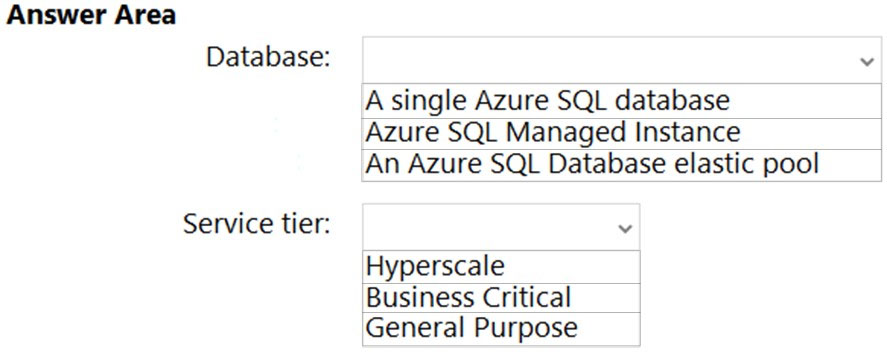
Free Access Full AZ-305 Practice Questions Free
Want more hands-on practice? Click here to access the full bank of AZ-305 practice questions free and reinforce your understanding of all exam objectives.
We update our question sets regularly, so check back often for new and relevant content.
Good luck with your AZ-305 certification journey!




